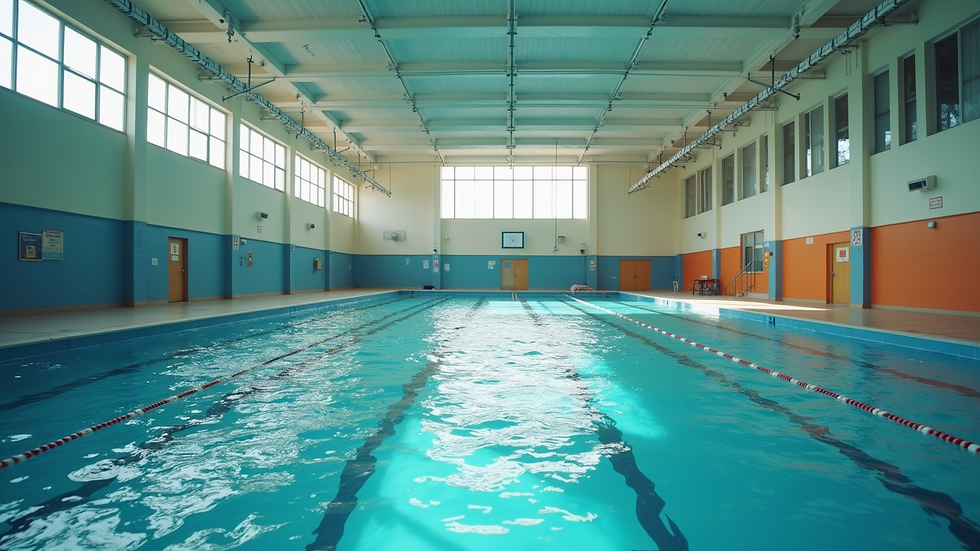Understanding the Financial Implications of Installing Swimming Pools in Educational Institutions
- Buildwith Voltech
- Jul 12
- 4 min read
Installing a swimming pool in a school or college can dramatically enhance the facility's offerings. It provides students with opportunities for physical education, recreation, and competitive sports. However, the decision to construct a swimming pool involves several financial aspects that must be carefully considered.
This blog post provides a detailed overview of the financial implications of installing swimming pools in educational institutions, examining initial investments, ongoing operational costs, and potential funding sources.
Initial Costs of Construction
The initial costs of constructing a swimming pool can vary widely based on factors such as the pool's size, depth, design, and location. For instance, typical construction costs for schools can range from $200,000 to over $1 million. Smaller, above-ground pools can cost around $100,000, while larger, in-ground pools with advanced features can exceed $1 million. Additionally, necessary facilities like locker rooms, restrooms, and seating areas can significantly add to the overall cost.
For example, a mid-sized school installing a 25-meter in-ground pool might spend approximately $500,000 when factoring in the construction of supportive amenities. Local construction codes and site conditions can also influence costs. Schools should conduct site assessments and consult with contractors to get tailored estimates.

Operational and Maintenance Costs
After constructing the pool, schools need to budget for ongoing operational and maintenance costs. These expenses usually include:
Utilities: The costs for heating, lighting, and water can add up quickly. For instance, a school might pay between $5,000 and $15,000 annually, depending on the pool size and usage patterns.
Staffing: Qualified personnel, like lifeguards and swimming instructors, are necessary for safety. Hiring a lifeguard could cost the school about $20,000 annually.
Chemical Treatments: Regular chemical treatments to maintain water quality can run from $2,000 to $5,000 per year.
Repairs and Renovations: Routine repairs and upgrades keep the pool safe and functional over time. A school might budget around $3,000 to $10,000 annually for these costs.
In total, annual maintenance costs for a school swimming pool can range from $30,000 to $100,000, depending on its size and frequency of use.
Funding Options for Schools
Fortunately, various funding sources are available for schools considering pool construction. These sources can include:
Government Grants: Numerous government programs provide grants for enhancing school facilities. For example, the U.S. Department of Education offers funding specifically for educational improvements.
Community Sponsorship: Local businesses may agree to sponsor the pool’s construction or maintenance in exchange for advertising opportunities or community goodwill. A local business could cover up to 50% of costs as part of a sponsorship deal.
Fundraising Programs: Schools can engage parents, alumni, and local communities through fundraising campaigns, which can raise thousands of dollars. A successful bake sale or car wash organized by students might yield $5,000 to $10,000.
Exploring and combining these options can help create sustainable financial strategies for schools
The Benefits of a School Swimming Pool
Investing in a swimming pool offers numerous advantages beyond financial implications. A well-functioning pool can promote physical activity among students, combating rising sedentary behaviors. According to the Centers for Disease Control and Prevention, only 24% of high school students meet the recommended levels of physical activity. Swimming can be a great way to change that.
Moreover, swimming pools offer team-building opportunities and foster discipline through water-based sports. They can also serve as community hubs for local competitions or events, drawing in families and raising school spirits.

Environmental Considerations
When building a swimming pool, schools should consider sustainability. Implementing energy-efficient systems and water-saving technologies can reduce long-term operational costs. For example, solar panels can be installed to power pool heating, potentially saving 30% or more on energy bills.
Choosing eco-friendly materials during construction can further lessen the environmental impact. Schools might consider using recycled materials for decking or energy-efficient lighting systems.
Compliance and Safety Regulations
Building a swimming pool comes with the responsibility of adhering to local health and safety regulations. Schools must follow guidelines set for water quality and pool design. In some cases, compliance costs can increase if changes are needed to meet these regulations. Consulting with experts during the planning phase can help schools identify compliance needs without overshooting budgets.
Long-term Financial Planning and ROI
Given the substantial investment in constructing and maintaining a swimming pool, effective long-term financial planning is critical. Schools should evaluate not only initial and ongoing costs but also potential returns on investment (ROI).
Positive outcomes may include:
Increased student enrollment due to improved facility appeal.
Increased revenue from hosting swimming competitions or community events.
By offering swimming lessons or swim team opportunities, schools can boost participation and community engagement, proving that a well-designed pool can be a valuable asset.
Final Thoughts on Pool Investment
While the financial implications of installing a swimming pool in a school or college are considerable, the potential benefits can make it a worthwhile investment. Understanding the complexities of financial planning, funding options, and compliance will empower educational institutions to make informed decisions.
With a detailed strategy and clear financial implications in mind, schools can foster vibrant environments that promote physical education and strengthen community bonds.




Comments